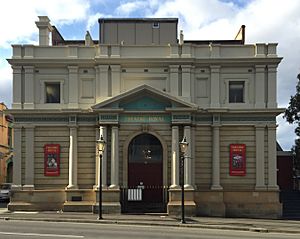Theatre Royal, Hobart facts for kids

The Theatre Royal exterior in 2015
|
|
| Address | 29 Campbell Street, Hobart 7000 Hobart, Tasmania Australia |
|---|---|
| Coordinates | 42°52′47″S 147°19′52″E / 42.8796°S 147.3311°E |
| Owner | Theatre Royal Management Board |
| Designation | Listed building |
| Capacity | 698 |
| Production | Ballet, opera, drama, repertory |
| Construction | |
| Opened | 1837 |
| Rebuilt | 1837, 1850s, 1890s, 1986 |
| Years active | 1834–1984 1986 – present |
| Architect | John Lee Archer |
| Place ID: | 2,191 |
| Status: | Permanently Registered |
The Theatre Royal in Hobart, Tasmania, is a very old and famous place where people watch shows. It's the oldest theatre in Australia that has been open all the time! Famous actors like Noël Coward and Laurence Olivier loved it very much. Olivier even helped raise money to save it in the 1940s.
Contents
The Theatre Royal's Story
Building the Theatre (1834-1856)
In 1834, a man named Peter Degraves, who started the Cascade Brewery, and some other people in Hobart decided to build a public theatre. They bought land near the docks. The architect, John Lee Archer, designed the building, and construction began that same year.
The area wasn't the fanciest part of town. It was near factories and pubs. To make it easy for everyone to visit, the architect even made an entrance through a nearby pub. This led directly to the cheaper seats, which people called "the Shades." When money became tight, Peter Degraves took over the whole project.
The theatre was finished by the end of 1836, with some help from convict workers. The first shows happened in March 1837. In June, it was officially named the "Royal Victoria Theatre" to honor Queen Victoria. But soon, everyone just called it "The Theatre Royal."
From 1840 to 1847, a woman named Anne Clarke managed the theatre. She brought in better performers and improved how the theatre was run. People said she made theatre more respected in Australia.
Changes and Challenges (1856-1911)
Because of its location, the theatre sometimes hosted unusual events like boxing matches and religious meetings. The audience from "the Shades" was known for being a bit rowdy!
Peter Degraves tried to improve the theatre in 1856, but it didn't help much. After he passed away in 1883, Richard Lewis bought the theatre. Over the next 40 years, Lewis worked to make it more stylish. In 1911, the inside of the theatre was completely rebuilt.
The new design, by architect William Pitt, featured red velvet seats, shiny gold decorations, and a beautiful crystal chandelier. The old "Shades" area was replaced with proper seating, and a new, higher balcony was added.
Saving the Theatre (1911-1952)
Even with the improvements, the theatre faced tough times. By the 1940s, it was in bad shape, with holes in the stage and unsafe wiring. It was almost torn down!
But in 1948, the famous actor Laurence Olivier visited Hobart. He loved the theatre and gave a powerful speech, asking people to save it. He said it was a "beautiful little theatre" with a long history.
His words worked! The government bought the theatre, and people raised money to restore it. By 1952, the renovations were complete. Special "Royal boxes" were even installed for a planned visit from Princess Elizabeth. The theatre reopened and became a popular place for shows again.
Fire and Rebuilding (1952-1986)
The theatre had many good years, with regular updates. In the early 1980s, a big renovation project started to celebrate the theatre's 150th birthday. They restored the beautiful 1911 decorations and added modern facilities backstage. This new backstage area became the Backspace Theatre, a smaller venue for different kinds of shows.
However, disaster struck on June 18, 1984. A fire started backstage and spread to the main theatre. The roof was damaged, and smoke and water ruined much of the furniture and equipment. Luckily, a fire curtain helped stop some of the damage.
People quickly started raising money again to rebuild "Australia's grand old lady of the theatre world." It took several years, but the theatre was determined to rise again.
A Modern Theatre (1986-Present)
The Theatre Royal finished its major rebuilding and reopened in March 1986. It quickly became a lively part of Hobart's social scene once more. The theatre now offers a yearly program of live theatre, music, dance, and other entertainment.
Since 1994, more and more people have been coming to see shows. The theatre has also embraced modern technology, with computer-controlled lighting and a digital ticketing system.
From 2018 to 2021, the theatre worked closely with The Hedberg performing arts centre. This included a new studio theatre, which replaced the old Backspace Theatre.
Fred the Ghost
The Theatre Royal has a friendly ghost named "Fred"! People say he was an actor who died in a fight in the basement. The theatre even used Fred's story to help raise money for repairs after the 1984 fire.
See also
List of theatres in Hobart

